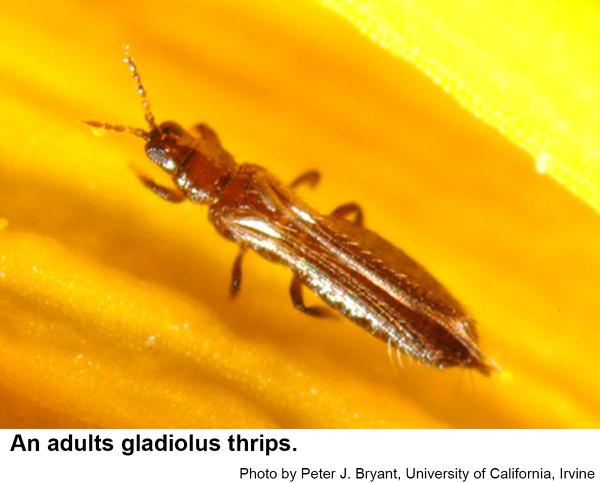Description and Biology
Gladiolus thrips, Taeniothrips simplex, are milky-white when they first molt, but soon turn dark brown except for lighter tips of the legs. The wings when folded over the back, are dark brown at the tips and lighter at the base with a gray band down the middle. Female adult gladiolus thrips are about 1/16 inch long. Males are smaller slightly smaller and lighter in color. Females lay extremely small, opaque, white, kidney-shaped eggs by inserting them into plant leaves, flowers, or corms. The larvae of the gladiolus thrips are light or pale yellow with red eyes and are smaller than adults. This thrips has two pupal stages. The first stage (prepupa) has short wing pads and the antennae project forward. The second stage or pupa has long wing pads and the antennae are folded back onto the head. Both stages are dark orange with red eyes and are slightly shorter than the adults. The pupal stages are sluggish but move about when disturbed. Gladiolus thrips are one of the most damaging pests of gladiolus. The gladiolus thrips feeds on the corms, stems, leaves and flowers of gladiolus. They overwinter readily on corms dug up and stored indoors, or they also overwinter on corms left in the soil. Development takes two to four weeks so that nine or more generations occur each year. Females deposit 100 to 200 eggs over their 35 to 40 day life span. Many times females greatly outnumber males in a population and any unmated females produce eggs that develop into males. Larvae and pupae can be found in the buds or leaf sheaths, although larvae also drop to the ground to transform into quiescent pupae.
Host Plants
The gladiolus thrips causes considerable damage to gladiolus. It also infests amaryllis, begonia, carnation, chrysanthemum, freesia, geranium, iris, lily, narcissus, poker plant, primula, snapdragon, tiger flower, and tomato. With their unusual mouthparts, they pierce or rupture tender leaf, flower and corm tissue and suck the plant juices that ooze out. Flower buds may be so injured that all of the blossoms are ruined.
Residential Recommendations
Several insecticides labeled for landscape use can be used as a spray to control gladiolus thrips. It is best to spray before the flowers open to avoid killing pollinators. If the corms are going to be dug for winter storage, they should be gently cleaned and soaked in bleach (4 teaspoons per gallon of water) for three hours. Let them dry thoroughly before boxing them up.
References
- Flower Thrips. Frank, S. et al. 2010 (revised). Entomology Insect Notes, NC State Extension Publications.
- Gladiolus (Gladiolus). Anonymous. 2007 (modified). The Connecticut Agricultural Experiment Station.
- Insect and related Pests of Flowers and Foliage Plants. Baker, J. R., ed. 1994. North Carolina Cooperative Extension Service Publication AG-136. 106 pp.
- Extension Plant Pathology Publications and Factsheets
- Horticultural Science Publications
- North Carolina Agricultural Chemicals Manual
For assistance with a specific problem, contact your local Cooperative Extension Center.
This Factsheet has not been peer reviewed.
Publication date: Jan. 11, 2017
Reviewed/Revised: Sept. 18, 2019
Recommendations for the use of agricultural chemicals are included in this publication as a convenience to the reader. The use of brand names and any mention or listing of commercial products or services in this publication does not imply endorsement by NC State University or N.C. A&T State University nor discrimination against similar products or services not mentioned. Individuals who use agricultural chemicals are responsible for ensuring that the intended use complies with current regulations and conforms to the product label. Be sure to obtain current information about usage regulations and examine a current product label before applying any chemical. For assistance, contact your local N.C. Cooperative Extension county center.
N.C. Cooperative Extension prohibits discrimination and harassment regardless of age, color, disability, family and marital status, gender identity, national origin, political beliefs, race, religion, sex (including pregnancy), sexual orientation and veteran status.




